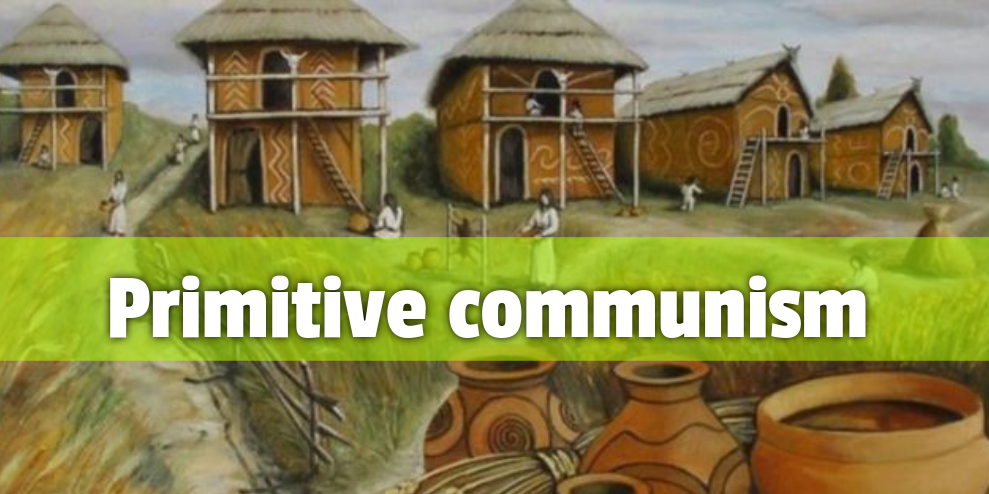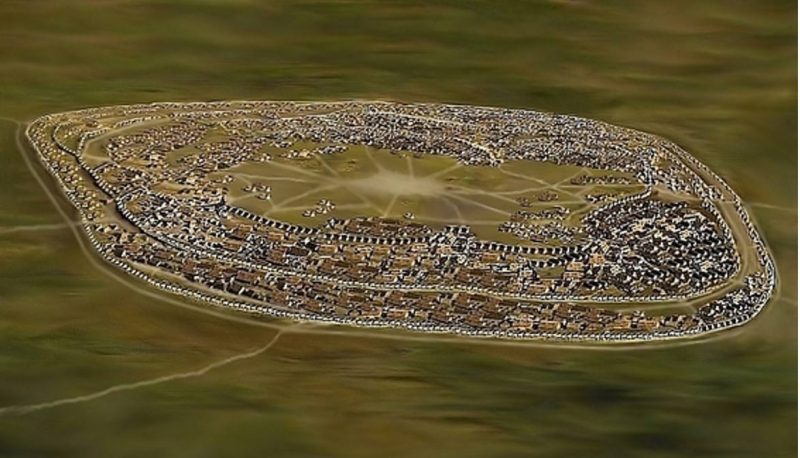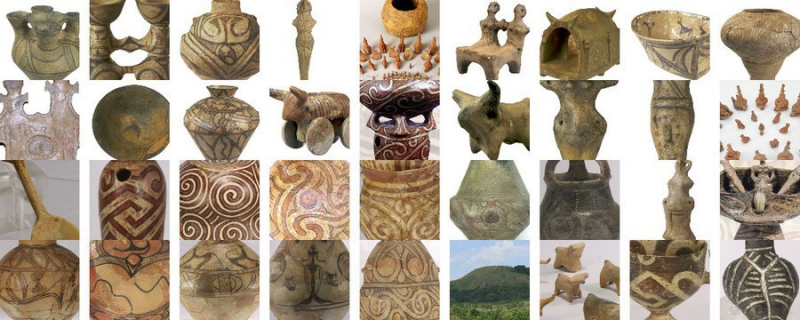Primitive communism

Primitive Communism: Mode of production under which Humanity lived for more than half a million years prior to the splitting of society into classes. Although for most of this period human communities were sustained by hunting, fishing and gathering, primitive Communism discovered agriculture, led the first sedentary life and sustained large cities for centuries.
Primitive Communism covers a period of more than 200.000 years. In the form of a community organization, Humanity spent most of that time living by hunting and gathering. About 9,000 years ago, the discovery and gradual development of agriculture and animal husbandry put this mode of production into crisis. In some places it would transform and evolve in the form of an agrarian communism based on land ownership for a few thousand more years. In others, society would split into classes, usually through conquest.
The revision of the traditional narrative by contemporary archaeology

Göbekli Teppe. Rest of animist cults.
Archaeological discoveries in recent decades paint a picture of a world in which primitive communism developed agriculture and livestock without splitting society into classes, produced large cities very different from those of the "Fertile Crescent" - although it is likely that these were also "communist" in origin - and resisted the emergence of exploiting classes until relatively recently, eventually living at the same time as the first Roman kings and the first Greek slave-democracy.
In the history that we were taught at school, the discovery of agriculture almost automatically led to sedentarization, urbanization and class division. This narrative did, however, show some obvious flaws. The first great productive revolution of our species, the end of half a million years of nomadic life that opened the door to the division into social classes, writing, developed religions, the first states... could not be explained as an improvement in productivity.
Farming required more resources and produced less than staying as nomadic hunters. For decades, all kinds of explanatory models were tried, but none of them were really successful. It seemed that our ancestors had willingly gone through hunger and hardship to learn how to grow crops and raise livestock, even though these practices would take many generations to become more profitable than hunting and gathering.
Klaus Schmidt, the archaeologist who led the excavation of Göbekli Tepe, for many the most important archaeological discovery to date, was the first to develop a satisfactory theory from the new evidence. Göbekli Tepe, discovered in 1994 and built some 11,500 years ago, some three millennia before the foundation of Uruk/Sumer, has become known in the media as "the first temple", but above all it is the first material vestige discovered so far of sedentarization and agricultural production.
Schmidt argued that Göbekli Tepe had been the center from which cultivation and livestock breeding spread towards what we call "the Fertile Crescent". But the builders of those buildings were still nomads and hunters. It would have been the maintenance needs of the sanctuary's own structures that would have generated the incentives to invest resources in the hard work of growing wild grains and domesticating some species.
It might be uneconomical in relation to hunting, but hunting required long journeys on a seasonal cycle, and if one wanted to stay in Göbekli, more and more time had to be spent caring for the wild grains around it. Even more so if, as it seems, the sanctuary regularly collected and housed cripples and sick people, functioning as a kind of "base" for a group that remained nomadic.
But one piece was still missing: What was the point of maintaining such an expensive and at the same time precarious structure? What did these shrines provide that was important enough to organize all community life around them?
The answer would be provided again by Göbekli Tepe. The discovery of large fermentation vats illuminated a new element. Parallel excavations in China, meanwhile, gave rise to the first theories that claimed that agriculture was a by-product of the need to produce alcoholic beverages for the periodic celebrations of those nomadic hunting parties.
In 2004, excavations in Jiahu, the oldest Neolithic Chinese village discovered so far, founded some 9000 years ago, provided a new clue. Archaeologist Patrick McGovern discovered the remains of a drink, a kind of chicha, which must have had about ten degrees of alcohol. What is more interesting is that the production of this primitive "beer" would have been, according to McGovern, the cause of sedentarization.
Sanctuaries such as Göbekli Tepe or settlements such as Jiahu or those that would have given rise to Sumer, would have been the result of the need of the communities and nomadic hunting parties to meet again to celebrate and redistribute the fruit of the work.
As in Göbekli Tepe, Jiahu did not originally house the entire tribe. It is quite possible that it was born as a settlement of only a few people who looked after "fermentable" crops that in each seasonal cycle allowed the production of the drink. These were drinks whose function was to be integrated into a kind of festival in which the nomadic community met again with their cripples and with the less productive and sacrificed farmers. McGovern points out:
No matter how we characterize these Neolithic drinks and the domestication of these plants, we will find that it is an egalitarian effort, with everyone working together.
In a primitive communist economy, celebration is the main collective mechanism of social cohesion. By uniting redistribution between farmers and hunters through ceremonial, the community, not divided into classes, affirmed without friction its egalitarianism. The fermentation of wild grains - the most primitive form of beer - begins to play an increasingly important role in these celebrations because they naturally become everyone's "goal". Every celebration needs something special. Thus something apparently uneconomic, such as sowing and cultivating full time becomes the object of a first division of labor that does not serve the exploitation of some by others.
There are still examples of this logic of primitive communism operating in living societies, for example the Enawene-nawe, whose society combines hunting and farming around a central cyclical festival. Each time the joint hunting and fishing parties return, a different house -which takes care of an orchard- organizes a community festival where the results of hunting and farming are redistributed while maintaining social organization. The houses are distributed radially and the house that must organize the festival changes from radius to radius like the cyclical Amazonian calendar.
This redistributive logic seems to have also been the origin of the first "global" networks. In all probability, a non-mercantile exchange more akin to the extensive Polynesian ritual exchange networks or those of the Northern Pacific Kwakiutl until the 20th century, than to the later trade of the Phoenicians or Greeks. Recent research into the DNA of British flora led a team of scientists to conclude that Neolithic communities in southern Europe shared seeds from cultivated grains with their more backward northern neighbors more than eight thousand years ago, two thousand years before the first known evidence of agriculture in the islands.
That is, "shrines" - originally the center of a tribe's hunting grounds - may also have served as a means of redistribution among tribes, spreading and equalizing advances in different geographical regions. The agrarian revolution created an interconnected world with long-distance exchanges long before the birth of the commodity.
The overall result is a picture of the Neolithic Revolution and the birth of civilization very different from that prevailing in the 20th century.
The primitive agrarian community did not have a social structure or a production cycle essentially different from those of the nomadic tribe. After the primitive communalism of hunter-gatherers that fascinated the first anthropologists, there did not immediately come the state, private property and the sexual and social division of labor, but a long phase of agrarian communism that continued to be sustained in part by hunting, fishing and gathering.
This productive system occupied wide geographical spaces, surely more connected to each other than we imagine. And what is more important: the great leap was not the discovery of agriculture itself, but the birth of the agrarian communal from the ceremonial logic of celebration.
The city under primitive communism

Cucuteni, a city of Primitive Communism
In the 1970s, the first archaeological discoveries of what was later called the Tripilia-Cucuteni culture emerged. In a vast region of today's Ukraine, Romania and Moldova, dozens of "megasites", Neolithic cities, have since been discovered. Their heyday was between 4500 and 3000 BCE. The problem for archaeologists is that the number of houses in each of them is overwhelming. In one of the last explored megasites, Nebelivka, during...
...more than six years of field work since 2009, researchers have excavated and mapped structures located in more than one square kilometer. Aerial photos, satellite images and geomagnetic data, supplemented by excavations of 88 test wells, identified 1,445 residential houses and 24 communal structures called assembly houses.
But the interesting thing is...
Researchers say there are no signs of a centralized government, a ruling dynasty or disparities in wealth or social class in the former settlement. The houses were largely similar in size and design. The excavations produced few "prestige" goods, such as copper items and shell decorations. Many examples of painted pottery and clay figures typical of the Tripilian culture were found, and more than 6,300 animal bones unearthed at the site suggest that the residents ate a lot of beef and lamb. These clues suggest that daily life was very similar in the different neighborhoods of Nebelivka.
The population of these megasites had nothing to envy from the Mesopotamian cities already formed under class division. The two largest megasites investigated, Talianki and Maidanets, housed at their peak 26,000 and 46,000 people respectively. However, they were built under a radically different urban planning system and priorities, such as their social organization.
One of the things that has attracted the attention of researchers has been the diversity and sophistication of the diet. The megasites grew wheat, oats, millet, rye and barley - as well as hemp used for textiles - but they also had orchard and fruit areas where remains of apricots, plums, cherries, grapes, peas and beans have been found.
Livestock farming, essential to allow the productive inclusion of the physically weaker members, was highly developed and it seems that the diet was rich in protein from domesticated pigs, goats and sheep, but also from hunting and fishing. And of course, fermentation of the grains - the ancient beer - and possibly grape wine were made.
But besides the egalitarianism of the houses and the dietary diversity, in what these cities of primitive communism differed from the Mesopotamian ones in their low spatial density. While Ur, at its peak occupied 89 Hectares and had about 60,000 inhabitants, the 3,000 houses of Maidanets occupied about 270 Hectares and the 2,700 houses of Talianki no more and no less than 450 Hectares.
The high density of the first class-divided cities as opposed to those of the the primitive communism obviously reflects the exploitation, but also the centralization of state power that has just been born to "mediate" between the classes themselves, but above all to maintain the system of exploitation. A concentrated population is easier to control and to manage with fewer resources.
The urban structure of the cities of primitive communism not only reflects an egalitarian distribution of space and access to the products of collective labor - as we saw in the diet - but the different nature of political power in a society without a state.
Proto-class struggle

Material culture of Primitive Communism. Rests discovered in Cucuteni.
Another thing that has caught the attention of megasite archaeologists is the appearance of burned houses at different times. In many cases the houses were not rebuilt. Only a gap was left with the ruins. Researchers initially blamed it on some form of ritual. It was one of those archaeological "mysteries". But really... not quite.
All over Eastern Europe, at the same time and after the "megasites" of Cucuteni, egalitarian cities appeared more or less big but very similar. They are known by the Latin word "oppida" (oppidum in singular). And there is archaeological evidence that they flourished until 580 BC and that just over 2000 years ago there were still some left. As the framework for understanding this type of city under primitive communism has expanded, other avenues of interpretation have emerged that are much more interesting than the ritual "deus ex machina".
Okolište in Bosnia had been founded around 5200 BC and contained family groups that apparently developed different economic and demographic potentials in their development. The houses of the richest families, who exercised a growing position of power within the large village, were burned down around 4900 BC. After this time, much changed in Okolište: the size of the village, which was originally too large for Neolithic conditions with approximately 3500 inhabitants, was reduced to a "standard size for Southeast Europe" of 100-200 inhabitants.
In addition, the differences between the households become unrecognizable and the specific functions of the Okolište centrality within the surrounding settlement are likewise indistinguishable. In this sense, in the case of Okolište we can assume that we are facing an internal rebellion against growing social differences and increasing differences in the management of resources.
In the three examples mentioned, the certainties and uncertainties in the management and reconstruction of internal social conflicts are evident. However, the processes in, for example, Heuneburg and Okolište can be compared. In both cases, the development of the growing economic potential of a group of households within the total population leads to internal social conflicts.
While a concentration of activities and political power in certain households is discernible in the Neolithic Okolište, in Heuneburg there is an entire district - separated from the rest of the settlement - in which craftsmanship and political control are concentrated. In both cases, social conflicts lead to a more dispersed settlement pattern and a reduction of social differences within society.
Johannes Müller. "Rebellion and Inequality in Archaeology", 2017
That is to say, differences in the demographic development of the different groups or tribes that converged in the city and the unequal extension within the community of certain activities -in other words, the development of the productive forces under primitive communism- would have incited conflicts tending to the emergence of classes. Once this point was reached, primitive agrarian communism could only restrain the process -weakening the fabric and the productive capacity of the social whole - or transform itself into a class society.
The record of burned houses shows us that primitive communism had the capacity to defend itself against its own internal dynamics. But it is quite possible that in some places - such as Eastern Europe - large concentrations atomized as a result of these internal conflicts. What we do know is that communities under primitive communism were dispersed or subdued by barbarian tribes.
This subjugation, in principle tribal, becomes class domination as the state develops as an instrument for the exaction of the conquered, as we see at the dawn of both the Asiatic mode of production and slavery.
http://dictionary.marxismo.school/Primitive communism